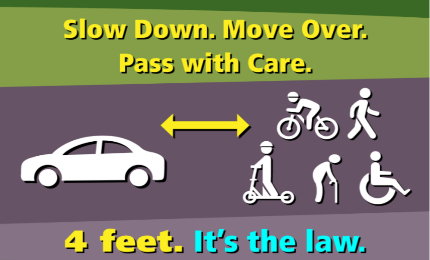On March 1, 2022 the State of New Jersey passed the New Safe Passing Law

The law is described below:
New Safe Passing Law
39:4-92.4 Definitions; procedures.
1. a. As used in this section:
“Bicycle” shall have the same meaning as set forth in R.S.39:4-14.5.
“Low-speed electric bicycle” shall have the same meaning as set forth in R.S.39:1-1.
“Low-speed electric scooter” shall have the same meaning as set forth in R.S.39:1-1.
“Pedestrian” shall include, but not be limited to, a pedestrian as defined in R.S.39:1-1, a person in a wheelchair or motorized wheelchair as defined in R.S.39:1-1, a person employed by or who contracts with any public utility company in this State, a property maintenance worker, or any other person who is permitted by law to be upon the roadway for work or recreation.
b. The operator of a motor vehicle approaching a pedestrian, bicycle, low-speed electric bicycle, low-speed electric scooter, or any other lawful personal conveyance located or operating in an area designated for pedestrians or those conveyances, as appropriate, on the roadways of this State shall approach with due caution and shall, absent any other direction by a law enforcement officer, proceed as follows:
(1) when possible under existing safety and traffic conditions, make a lane change into a lane not adjacent to the pedestrian or personal conveyance;
(2) if a lane change cannot be made pursuant to paragraph (1) of this subsection, leave a reasonable and safe distance of not less than four feet while approaching the pedestrian or personal
conveyance and maintain a distance of at least four feet until the motor vehicle has safely passed the conveyance; or
(3) if it is not possible, prohibited by law, or unsafe to make a lane change pursuant to paragraph (1) of this subsection or to leave a reasonable and safe distance of not less than four feet pursuant to paragraph (2) of this subsection, the motor vehicle operator shall reduce the speed of the motor vehicle to 25 miles per hour or a lower posted speed and be prepared to stop; the operator may pass the pedestrian or personal conveyance only if, considering the size and speed of the motor vehicle, traffic conditions, weather, visibility, and the surface and width of the roadway, passing does not endanger the safety of a pedestrian, operator of the personal conveyance, or any other person on the roadway.
c. A person who commits a violation of the provisions of this section which results in bodily injury as defined in N.J.S.2C:11-1 shall be fined $500 and assessed two motor vehicle penalty points; if no bodily injury results, the violator shall be fined $100 and shall not be assessed any penalty points.
d. Nothing in this section shall be construed to preclude or limit a prosecution or conviction for a violation of any offense defined by the laws of this State or for any violation of Title 39 of the Revised Statutes.